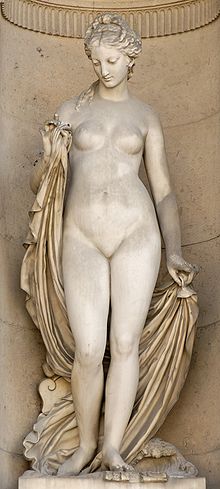art.wikisort.org - Artist
Jean-Jules Allasseur (13 June[1] 1818 — 1903) was a French sculptor, a pupil of Pierre-Jean David called David d'Angers[2] at the École des Beaux-Arts, Paris, who produced portrait sculptures, memorial allegories and decorative architectural sculpture for official commissions under the Second Empire. He was made a chevalier of the Legion of Honor, 7 August 1867.

He is buried at the cemetery of Montmartre (14th division)[3] where he kept his studio.[4]
Selected works
- La Découverte de Moïse, shown in plaster at the Paris Salon of 1853 and in marble, 1859.
- François de Malherbe (1853), one of the eighty-six standing figures of famous Frenchmen in Hector Lefuel's Cour Napoléon of the Louvre Palace.[5]
- Monument of Jean Rotrou (bronze, 1866) for Dreux, adapting and simplifying the features of the famous bust by Caffieri for the foyer of the Comédie-Française.[6]
- Saint Joseph for Saint-Étienne-du-Mont, Paris.
- Saint Carlo Borromeo (1867) for Saint-Étienne-du-Mont.
- Rameau (marble, 1888) for the Académie nationale de musique. Shown at the Paris Salon of 1888.[7]
- Le Pêcheur (Louvre Museum).
- Leucothea (Louvre Museum).
Notes
- According to the Dossiers de proposition de Légion d'Honneur, 1852-1870 (Paris) 2005 (pdf file); The date 1 July is usually given in secondary sources.
- In 1858 he collaborated with Armand Toussaint in restoring David d'Anger's sculpture La Jeune Grecque, prior to its being returned to Greece in 1866 (Ekaterini Kepetzis, "Bemerkungen zu David d’Angers als Republikaner und Philhellene" note 43 (on-line text)
- Cimitière Montmartre
- Dictionnaire des peintres à Montmartre (Paris: Roussard) 1999).
- "Les 86 statues des hommes illustres" Archived 2006-11-24 at the Wayback Machine
- Noted with approval by Émile Zola in his review of the Salon (on-line text Archived 2007-06-10 at the Wayback Machine).
- plate F/21/*7658]
На других языках
- [en] Jean-Jules Allasseur
[es] Jean-Jules Allasseur
Jean-Jules Allasseur, nacido el 13 de junio[1] de 1818 y fallecido en 1903, fue un escultor francés.[fr] Jean-Jules Allasseur
Jean-Jules Allasseur, né à Paris le 1er septembre 1818[1] où il est mort dans le 18e arrondissement le 23 mars 1903[2], est un sculpteur français.[ru] Аллассёр, Жан-Жюль
Жан-Жюль Аллассёр (фр. Jean-Jules Allasseur; 1 сентября 1818, Париж[1] — 23 марта 1903, там же[2]) — французский скульптор.Текст в блоке "Читать" взят с сайта "Википедия" и доступен по лицензии Creative Commons Attribution-ShareAlike; в отдельных случаях могут действовать дополнительные условия.
Другой контент может иметь иную лицензию. Перед использованием материалов сайта WikiSort.org внимательно изучите правила лицензирования конкретных элементов наполнения сайта.
Другой контент может иметь иную лицензию. Перед использованием материалов сайта WikiSort.org внимательно изучите правила лицензирования конкретных элементов наполнения сайта.
2019-2025
WikiSort.org - проект по пересортировке и дополнению контента Википедии
WikiSort.org - проект по пересортировке и дополнению контента Википедии